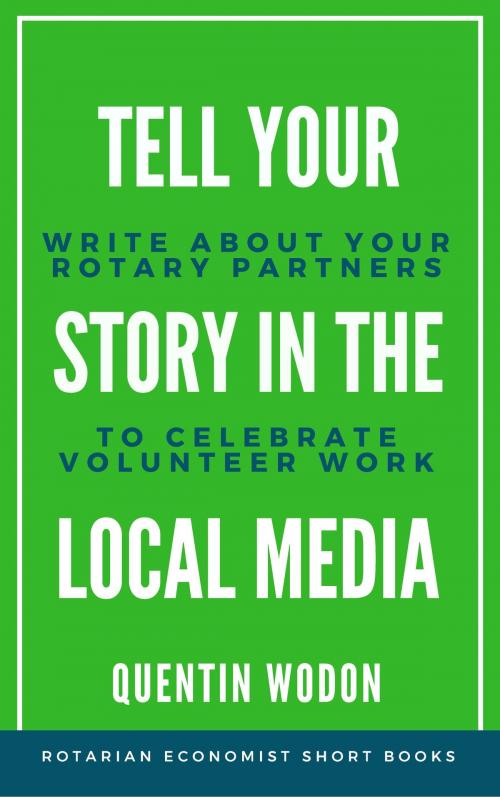Tell Your Story in the Local Media: Write about Your Rotary Partners to Celebrate Volunteer Work
Nonfiction, Social & Cultural Studies, Social Science, Volunteer Work, Business & Finance, Industries & Professions, Nonprofit Organizations & Charities| Author: | Quentin Wodon | ISBN: | 9781946819055 |
| Publisher: | Quentin Wodon | Publication: | March 12, 2017 |
| Imprint: | Smashwords Edition | Language: | English |
| Author: | Quentin Wodon |
| ISBN: | 9781946819055 |
| Publisher: | Quentin Wodon |
| Publication: | March 12, 2017 |
| Imprint: | Smashwords Edition |
| Language: | English |
As is the case for many nonprofits, the success of Rotary clubs depends in part on the image that communities have of the organization. Public image – the term often used in Rotary – matters especially for membership, both to attract new members and to keep the members clubs already have. But it also matters for the ability of Rotary to implement service projects in local communities and internationally. Finally, it matters for fundraising for charitable purposes in order to fund the projects that clubs undertake.
Relationships with the local media, and the way clubs are covered in the local media, are a major factor affecting a club’s public image. This book shares lessons from my experience on behalf of my club in improving the club’s public image by publishing articles in the local traditional media. The hope is that the lessons learned – and the examples of articles written, will be useful to other service clubs as well as other nonprofits that may consider similar endeavors.
The premise of this book is that service clubs should aim to strengthen their public image. This premise is informed not only by my own experience as a Rotarian, but also by data that collected for my district through a membership survey on what Rotarians perceive is working well in their club, and what is not working so well. Essentially, Rotarians rated the performance of their clubs in terms of engagement with the local media at the bottom of the scale in comparison to their perception of their club’s performance in other areas.
Until recently, my own club’s engagement with the local media was not much better. We were not well known in the community and had virtually no contacts with the local media. As our membership was declining, we had to make a change in this area as well as in many others. With the aim of increasing our membership after years of decline, we adopted a strategic plan and pilot program for a period of six months. One of the plan’s dimensions was a stronger engagement with the local community including through the local media.
First, we used club meetings to invite leaders from local nonprofits to tell us their own story. Second, we decided to participate in more community events. Third, we started to organize more public events ourselves. Fourth, and this is what this book is about, we started to write stories for local media outlets, both traditional and social.
The basic idea for this new endeavor was that instead of writing articles about our club, we should write about the great work that local nonprofits, many of which we support in our service work, do in the community. More specifically, we should write about the opportunity for residents of the community to volunteer for great nonprofits and thereby make a difference in the community.
There were four reasons for this choice of topic. First, writing about other nonprofits instead of our club would provide an opportunity to write more articles, and thereby establish a stronger media presence in the community. Second, by documenting the work of local nonprofits and the volunteering opportunities they provide, we would help these nonprofits gain in visibility, which would then almost be a worthwhile service activity in itself for our club. Third, these articles could help our club solidify collaborations with some of the local nonprofits featured in the articles, or open doors for new collaborations. Fourth, by writing stories about nonprofits in action (and mentioning occasionally the role of Rotarians in helping them), we would build an image of our club as an action-oriented agent for positive change in the community.
The first chapter of the book explains what we did and why. The second chapter provides the set of articles that were written for local traditional media outlets at the time of publishing this book. A brief conclusion follows with some key lessons learned.
As is the case for many nonprofits, the success of Rotary clubs depends in part on the image that communities have of the organization. Public image – the term often used in Rotary – matters especially for membership, both to attract new members and to keep the members clubs already have. But it also matters for the ability of Rotary to implement service projects in local communities and internationally. Finally, it matters for fundraising for charitable purposes in order to fund the projects that clubs undertake.
Relationships with the local media, and the way clubs are covered in the local media, are a major factor affecting a club’s public image. This book shares lessons from my experience on behalf of my club in improving the club’s public image by publishing articles in the local traditional media. The hope is that the lessons learned – and the examples of articles written, will be useful to other service clubs as well as other nonprofits that may consider similar endeavors.
The premise of this book is that service clubs should aim to strengthen their public image. This premise is informed not only by my own experience as a Rotarian, but also by data that collected for my district through a membership survey on what Rotarians perceive is working well in their club, and what is not working so well. Essentially, Rotarians rated the performance of their clubs in terms of engagement with the local media at the bottom of the scale in comparison to their perception of their club’s performance in other areas.
Until recently, my own club’s engagement with the local media was not much better. We were not well known in the community and had virtually no contacts with the local media. As our membership was declining, we had to make a change in this area as well as in many others. With the aim of increasing our membership after years of decline, we adopted a strategic plan and pilot program for a period of six months. One of the plan’s dimensions was a stronger engagement with the local community including through the local media.
First, we used club meetings to invite leaders from local nonprofits to tell us their own story. Second, we decided to participate in more community events. Third, we started to organize more public events ourselves. Fourth, and this is what this book is about, we started to write stories for local media outlets, both traditional and social.
The basic idea for this new endeavor was that instead of writing articles about our club, we should write about the great work that local nonprofits, many of which we support in our service work, do in the community. More specifically, we should write about the opportunity for residents of the community to volunteer for great nonprofits and thereby make a difference in the community.
There were four reasons for this choice of topic. First, writing about other nonprofits instead of our club would provide an opportunity to write more articles, and thereby establish a stronger media presence in the community. Second, by documenting the work of local nonprofits and the volunteering opportunities they provide, we would help these nonprofits gain in visibility, which would then almost be a worthwhile service activity in itself for our club. Third, these articles could help our club solidify collaborations with some of the local nonprofits featured in the articles, or open doors for new collaborations. Fourth, by writing stories about nonprofits in action (and mentioning occasionally the role of Rotarians in helping them), we would build an image of our club as an action-oriented agent for positive change in the community.
The first chapter of the book explains what we did and why. The second chapter provides the set of articles that were written for local traditional media outlets at the time of publishing this book. A brief conclusion follows with some key lessons learned.















